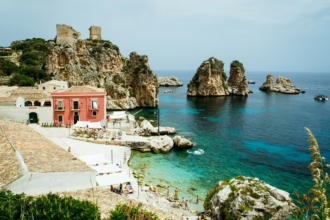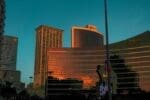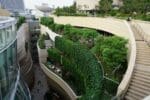When evaluating a property, your focus instinctively turns to location, square footage, and condition. But in a world of increasingly hot summers and rising energy bills, a new, data-driven factor is coming to the forefront and starting to dictate the future value of real estate: measurable sustainability.
Content
This is no longer a theoretical concept but a quantifiable reality. A pioneering project named Re-Leaf, developed by the world-renowned Massachusetts Institute of Technology (MIT) in partnership with the visionary Dubai Future Foundation, is using artificial intelligence to prove what we’ve long felt intuitively: trees are critical urban infrastructure. Their research shows that the right tree species can cool their surroundings by up to 15°C. This technological revolution provides the data behind one of the most important new factors in property valuation-the green premium.
From Amenity to Infrastructure: Insights from MIT’s Re-Leaf Project
At the heart of this shift is a simple yet powerful idea, articulated by the MIT team: “By seeing trees not just as greenery but as infrastructure, we can rethink how cities adapt to a warming planet.”
Using a combination of AI, satellite, and thermal imagery, the Re-Leaf project has created the first-of-its-kind “Cooling Catalogue.” It doesn’t just count trees; it analyzes which species are most effective for a specific climate. For instance, in arid regions like the UAE, the study proves that native, drought-resistant species like the Neem tree are significantly more effective than commonly planted palms. The partnership with the Dubai Future Foundation transforms Dubai into a global living lab, demonstrating that this is a strategic asset for the future of cities.
The Investor’s Analysis: The “Green Premium” vs. the “Brown Discount”
For an investor, the numbers speak loudest. The idea of a property with superior thermal comfort translates directly into financial terms.
Calculating the ROI of the “Green Premium”
The term “green premium” describes the proven higher market value of sustainable properties. This value is generated in several ways:
- Higher Capital Value (5% to 20%): Multiple studies confirm that properties with quality green spaces and mature trees sell for 5% to 20% more.
- Lower Operating Costs (up to 30%): Effective shading can reduce air conditioning costs by up to 30%.
- Higher Rents and Lower Vacancy: Green properties attract higher-quality tenants willing to pay more for comfort and lower utility bills.
A Hypothetical Example: Consider a €5,000 investment in professional landscaping for a €300,000 property.
- Value Appreciation: A conservative 5% increase would add €15,000 to the property’s value.
- Energy Savings: A 15% reduction on an annual €2,000 cooling bill equals €300 saved each year. In this scenario, the investment not only pays for itself almost immediately but also generates passive income. For a more detailed look at how to calculate these metrics, read our ROI guide.
Risk Management: The “Brown Discount”
The flip side of the “Green Premium” is the “Brown Discount.” Buildings that fail to meet modern sustainability standards will become increasingly unattractive and even unsaleable. Investors now estimate that an average of 11% of their portfolios are at risk of becoming stranded assets due to non-compliance with sustainability criteria. Ignoring these factors today is a direct financial risk for tomorrow.
Actionable Strategies for Every Investor
Whether you’re a novice or managing a large portfolio, you can capitalize on this trend.
For New and Off-Plan Properties
- Use Data: Insist on a data-driven design in the style of Re-Leaf – the right trees in the right places.
- Market the Performance: Instead of “lush greenery,” communicate “proven lower cooling costs” and “a measurably cooler microclimate.”
- Seek Green Financing: “Green mortgages” are emerging across Europe, offering lower interest rates for energy-efficient properties. Banks in Spain and Italy are actively promoting such products.
For Existing Properties (Retrofitting)
- Strategic Planting: Plant deciduous trees on the south and west sides of the property.
- Vertical Gardens and Green Roofs: An excellent solution for buildings with limited space, they cool, improve air quality, and reduce noise.
- Efficient Irrigation: Invest in a smart drip irrigation system to significantly reduce water use.
Property Viewing Checklist: Assess the Thermal Comfort Potential
For the Novice Investor: When viewing a property, use this short checklist to look beyond the four walls.
- Afternoon Shade: Are there mature trees shading the building, especially the west and south-facing windows?
- Health of Greenery: Do the trees and gardens look healthy and well-maintained? Sick plants are a future expense.
- Hardscape Ratio: How much of the property is covered in heat-absorbing concrete or asphalt? The less, the better.
- Ask About the Bills: Don’t be shy to ask: “What are the average electricity bills for July and August?”
Where This Factor Matters Most Today
- Dubai & UAE: As a partner in the Re-Leaf project, Dubai is at the forefront. Initiatives like the Dubai 2040 Urban Master Plan and the “Dubai Green Spine” project show this is a national strategy.
- Italy (Rome): Studies show the “urban heat island” effect in Rome can increase cooling energy needs by up to 81%.
- Spain (Madrid): Madrid suffers from one of Europe’s most severe UHI effects, with city center temperatures reaching 8.5°C higher than its surroundings.
- Greece (Athens): Here, temperature differences due to UHI can exceed 10°C.
- Turkey (Istanbul): Rapid urbanization has led to a doubling of built-up areas, directly increasing temperatures and energy consumption.
Investor’s Glossary
- Urban Heat Island (UHI): A phenomenon where urban areas are significantly warmer than surrounding rural areas due to heat absorption by buildings and asphalt.
- LEED / BREEAM: Leading international certification systems for “green” buildings. They assess sustainability across criteria like energy efficiency and environmental impact.
The Investment Takeaway: The Future is Sustainable
While most investors continue to focus on traditional metrics, innovations like Re-Leaf prove that thermal comfort is the next major factor in real estate valuation in hot climates. Investing in sustainable real estate is no longer a luxury but a smart strategy for risk management and higher, more stable returns. Understanding this trend is what will separate the informed investor from the rest of the market in the coming decade.
You might also like:
- Investing in property in Dubai: Why 2025 is a good time
- Turkey’s Real Estate Market in 2025: An Analysis of Risks, Stability, and Forecasts
- Mortgage for Foreigners in Europe: Spain, Greece & Italy Compared (2025)
This post is also available in: Български







